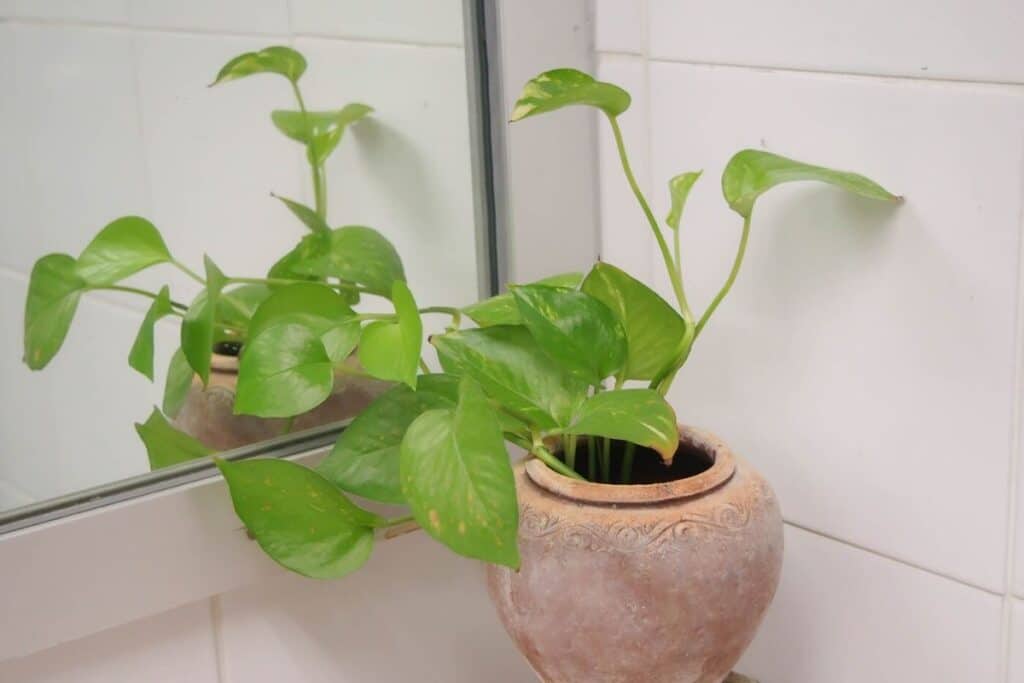Trailing and hanging plants have become trendy these days. Vines that drape by the window and spill over shelves are popular among modern house plant growers and one of their go-to plants is the pothos (also known as Epipremnum aureum).
Growing pothos is a no-brainer, it does not demand close attention and is very easy to propagate. If you have a tight space that needs tropical warmth, pothos is a great indoor plant option, one that can surely keep up with your busy schedule.
What is a pothos?
Pothos plants (Epipremnum aureum) are tropical vine natives of the Solomon Islands in the South Pacific. In their natural habitat, they thrive as climbing vines in tropical rainforests, clinging to trees and rock faces with their aerial roots. The species has also naturalized in many other tropical regions worldwide, including Southeast Asia, Australia, and Hawaii.
This tropical vine plant is one of the eight species of Epipremnum belonging to the Arum family (Knight). Upon its discovery in the 1800s, the plant was identified as Pothos aureus but later on, after further study for proper plant identification, it was finally renamed Epipremnum aureum.
Pothos is also commonly called Devil’s ivy because of its prolific growth and persistence even in full shade. Its simple heart-shaped dark green leaves appear on long vining stems that produce roots to cling on surfaces (1).
Indoors, the plant trails and reaches over 3m long, depending on trimming but in the wild, the plant grows big and can climb trees as high as 20m (2)!
Pothos Plant Care Guide
Pothos may be a common plant but it remains popular because of how inexpensive and effective it is in any indoor setting. Considered as one of the best tropical plants for indoors even for beginners, pothos is very easy to grow and maintain.
Light and Temperature Requirement
Epipremnums generally tolerate low light to bright light. Studies show that their growth rate is increased with bright light and indoors, fluorescent light works best (3).
Leaf variegation in many pothos varieties and species is affected by light as well. Although new heart shaped leaves naturally emerge green, the variegation becomes more pronounced as the plant matures and when exposed to bright light (1).
Pothos is a versatile plant, able to grow in almost any indoor setting. But for optimum growth, it should be kept in a room at 60-85 ºF (15-29 ºC). It can tolerate winter colds of up to 50 ºF (10 ºC) but will die below this (4).
Soil
Pothos plants thrive in a well-draining, lightweight potting mix. Use a combination of peat-based or loamy soil with perlite or sand to ensure good drainage.
Avoid soggy soil, as it can lead to root rot. Amend the soil with organic matter like compost to improve fertility and soil structure. Repot the plant every 1-2 years to refresh the soil and provide ample space for root growth.
Water
Pothos plants prefer evenly moist soil but can tolerate periods of slight dryness between waterings. Water the plant thoroughly when the top inch of soil feels dry to the touch, allowing excess water to drain away.
Avoid overwatering, as this can lead to root rot. During the growing season (spring and summer), water more frequently, reducing watering in the winter when growth slows.
Fertilizer
Pothos plants (Epipremnum aureum) are low-maintenance houseplants that thrive with minimal fertilizer. Use a balanced liquid fertilizer diluted to half-strength, applied every 4-6 weeks during the growing season (spring and summer).
Alternatively, use a balanced houseplant fertilizer applied once in the spring. Avoid over-fertilizing, as this can lead to salt buildup in the soil and damage the plant’s roots. Flush the soil with water occasionally to prevent salt buildup.
Because pothos plants are tolerant of neglect and can bounce back from setbacks, they will remain alive and healthy with a conservative fertilization schedule, frequent hydration, and enough light.
Propagate and Repot
The most common way of propagating pothos is by cuttings (1). Usually, cuttings of 3-5in are obtained from overgrowing stems. The end that has protruding root nodes is placed in water or in a growing medium made of soil, coco coir, and sand.
The propagules may take 1-2 weeks to grow roots and up to a month before they can be transplanted. Watering during this period must be monitored to ensure that the plant recovers from the change. Once the plant is established, it can last for 10 years or more (3).
Because pothos is a vigorous grower, it has the tendency to develop roots and shoots profusely. Pruning once or twice a year will keep the potted plant full and bushy.
During spring, the pothos should be root pruned and repotted to allow better aeration and to replenish the soil nutrients. Although it does not require regular application of fertilizer, feeding once a month can help keep the plant looking lush and healthy (5).
Pests
Like most indoor plants, pothos is vulnerable to white cottony insects called mealybugs that infest the stem and undersides of leaves. This can be treated by wiping the infested parts alcohol-drenched cotton or rag.
Some soil-borne fungi also cause root rot, leading to wilting yellow leaves and stems. The best way to get rid of this is to dispose of the infected plant and soil.
There is also a bacterial leaf spot disease causing brown spots on leaves surrounded by yellow halos. Removing the infected parts will help prevent the spread of the disease (3).
Is Epipremnum Aureum Toxic to Pets and Humans?
Low-maintenance and air purifying, pothos is the ideal plant to grow in offices and houses. However, there is a reason why they are kept high up on shelves or hanging, aside from the cascading effect of its growth.
Like the other members of its family, the leaves and stems of a pothos plant contain oxalate crystals, which causes swelling and a burning sensation in the mouth when ingested. Inflammation may also occur if the plant juices are rubbed in the eye (2).
Pets that have ingested any part of the plant may salivate and vomit but unless these symptoms are severe and excessive, there is no need for treatment. It is best to keep the plant out of their reach.
See more: A list of plants that are toxic to dogs and cats
What are the Best Types of Pothos for Indoors?
1. Neon
True to its name, this golden pothos variety appears like it is glowing. The leaves are golden yellow without variegation. Under bright light, the younger leaves tend to be livelier than the older ones.
2. Marble Queen
The heart-shaped leaves have a heavy variegation of shades of green and white, often with cream white being more prominent. It is one of the hardiest pothos that survive cooler temperatures.
3. Manjula
This pothos was produced by the University of Florida. The glossy leaves and stems come in shades of white, silver, and green, each foliage displaying a different pattern every time.
4. Pearls and Jade
A sport of Marble Queen, this pothos showcases the same white and green colors but in larger patterns. Although the leaves are smaller, the variegation is noticeable with white markings speckled with light green appearing on the edge of the leaves.
5. Satin Pothos
Unlike the other pothos, the Satin pothos has a matte texture and is velvety to the touch. This is because it is only a cousin of the Epipremnums but is grown and maintained just the same. The green color of the leaves and stem is muted with flecks of silver all over.
Also, don’t forget to check our list of other indoor vine plants you can grow.
FAQs
Do pothos need direct sunlight?
No, Pothos (Epipremnum aureum) can tolerate low to moderate light conditions and do not require direct sunlight. They thrive in bright indirect light but can also adapt to lower light levels, making them versatile and suitable for various indoor environments.
Are pothos easy to keep alive?
Yes, Pothos are known for their resilience and are generally considered easy to keep alive, even for beginners. They are forgiving plants that can tolerate occasional neglect, low humidity, and irregular watering. With proper care, pothos can thrive and remain healthy for many years.
Where should I place my pothos?
Place your pothos in bright, indirect light, like near a north- or east-facing window. They can also thrive in low light, making them versatile for various indoor spaces. Avoid direct sun light to prevent leaf damage.
See more:
References
Reference List
(1) DelPrince, J. “Interior Plantscaping: Principles and Practices”. 2013. Cengage Learning. P. 576.
(2) Knight, A. “A Guide to Poisonous House and Garden Plants”. 2007. CRC Press. P. 324.
(3) Pleasant, B. “The Complete Houseplant Survival Manual”. 2012. Storey Publishing. P. 384.
(4) Poole, R. et al. “Pothos Production Guide”. 1991. University of Florida. Accessed on July 12, 2020 at https://mrec.ifas.ufl.edu/Foliage/folnotes/folnotes.htm
(5) Baker, S. “The Complete Guide to Keeping Your Houseplants Alive and Thriving”. 2011. Atlantic Publishing Company. P. 288.
Close
*Photo by npatana/depositphotos







